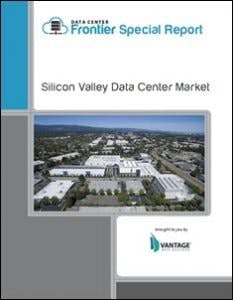Fiber Connectivity Benefits Silicon Valley Data Center Market
We continue our series of stories on the leading geographic markets for data center space with a report on the Silicon Valley Data Center Market. Data Center Frontier is partnering with DatacenterHawk to provide in-depth market reports on each city we profile. In this post, we take a look at the current Silicon Valley business environment for data centers, including disaster risk, power cost, incentives and more.
Download the full report.
Connectivity
Legacy carriers AT&T, Sprint and Verizon all run long-haul fiber connections on the west side of San Francisco Bay. These fast connections to the Internet backbone link tech businesses from San Francisco in the north to the concentrations of data centers south of the Bay in Santa Clara and San Jose.
Fiber from newer carriers CenturyLink, Cogent, Electric Lightwave, Integra, Level3, M Power, Paxio, Telepacific, XO Communications and Zayo all follow similar paths but also add connections to east Bay Area-suburbs of Berkeley and Oakland in the north, out to the growing eastern suburbs of Dublin, Pleasanton and Livermore, and circle back southwest to link up to San Jose/Santa Clara. Northern California also has a half-dozen localized fiber providers servicing specific areas.
Municipal fiber is available in Palo Alto, Sun Bruno (just south of San Francisco proper) and San Leandro, while Wilcon and Northern California Fiber serve the data center-heavy areas in Santa Clara and San Jose.
Power
Power pricing is a meaningful competitive factor in Silicon Valley, where the average power costs range from 9 to 15 cents per kilowatt hour (kWh), significantly higher than competing data center markets.
Within the Silicon Valley market, Santa Clara has emerged as the prime location due to power pricing from the municipal utility, Silicon Valley Power, whose rates average 25-40% lower than the cost of power from PG&E in surrounding towns.
Silicon Valley Power’s base rate for large industrial customers is about 22 percent lower than the average for PG&E in surrounding towns. Santa Clara does not have a city user tax, which means another 5% savings for customers compared to San Jose or 3% compared to Sunnyvale. In addition, Silicon Valley Power negotiates volume discounts with customers that use a large amount of power, but those rates are kept confidential.
Northern California has a reliable and extensive electrical grid. Both PG&E and Silicon Valley Power encourage using renewable power such as solar, wind and the more exotic biomass solutions.
One exception to the broader pricing trends is the STACK Infrastructure data center in San Jose (formerly Fortune/Infomart), which qualifies for PG&E’s Direct Access program. The program allows it to competitively source power directly from other electricity providers. STACK says it can offer power rates around 9 cents per kilowatt hour, compared to about 10 cents in Santa Clara and 13 to 15 cents per kWh in other PG&E service areas.
It is unclear at present how PG&E’s bankruptcy and legal woes will impact power pricing and the Silicon Valley business environment, but the company’s journey bears close watching.
These costs often factor into the decisions for Northern California-based companies to locate in the Pacific Northwest, where the power cost for data center users is considerably cheaper, with markets like Quincy, Wash., offering power for as little as 3 cents per kWh.
Northern California has a reliable and extensive electrical grid. Both PG&E and Silicon Valley Power encourage using renewable power such as solar, wind and the more exotic biomass solutions. However, these “green” power sources can often increase a data center’s total cost of ownership.
Many data centers need large amounts of water to cool their facilities. Newer facilities now use free-air cooling and rooftop DX cooling technologies.
Disaster Risk
The largest natural hazard threat in the Northern California market is earthquakes. According to the United States Geological Survey’s 2014 findings, the Northern California market is in one of the areas most likely to be impacted by an earthquake. Because of this, data center users and providers have invested significant capital in building facilities designed to handle these seismic events. As we noted earlier, some providers are marketing advanced seismic protection systems as competitive differentiators.
Another challenge for the Northern California market is the availability of water. Many data centers need large amounts of water to cool their facilities, and the multi-year drought in California creates challenges for data center operators.
Newer facilities now use free-air cooling and rooftop DX cooling technologies. Although some media coverage has created a perception that data centers abuse Northern California’s limited resources, the data center industry as a whole worked hard even before California’s provincial water crisis to conserve and use water in environmentally-friendly ways. As far back as 2005, numerous data centers (including many in Northern California) received Leadership in Energy and Environmental Design (LEED) certifications designed to conserve both water and electricity.
A current concern is the risk from wildfires, which is a front-of-mind issue after the extensive loss of life and property in recent wildfires affecting Santa Rosa and Paradise in Northern California. The only recent incidence of wildfires in the region has occurred in the Santa Cruz mountains, south of the developed property in San Jose and Los Gatos.
Nonetheless, in recent months Santa Clara County officials have proposed multi-million-dollar investments in additional staff and equipment to centralize the county’s management of wildlands and reduce reliance on equipment and resources that are shared with other agencies.
Economic Development and Incentives
Tax abatement opportunities are not currently available through the State of California. Brook Taylor, a spokesman for the California Governor’s Office of Business and Economic Development, told the Associated Press in 2015 that: “If anything, [data centers] are being built in spite of the fact that we don’t have specific tax credits or incentives for them.” Local tax abatement opportunities do exist in certain markets in Northern California.
See below for additional entries in this special report series:
- Silicon Valley Data Center Market Sees Robust Leasing Activity
- Companies see Silicon Valley Data Center Space as ‘Strategic Imperative’
- Multiple New Projects to Help Address Growing Silicon Valley Data Center Demand
For full details on the Silicon Valley data center market, we invite you to download the Data Center Frontier Special Report: The Silicon Valley Data Center Market, sponsored Vantage Data Centers.
About the Author



